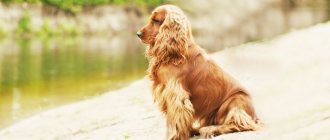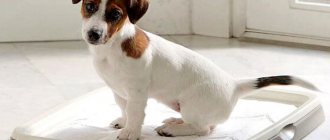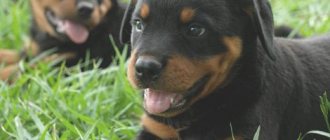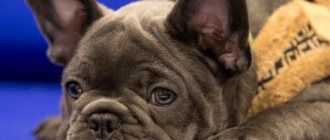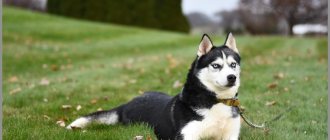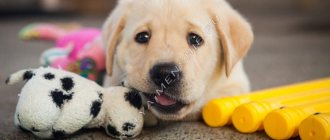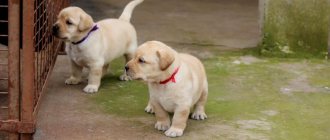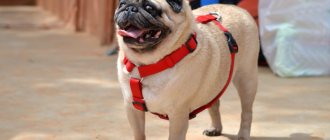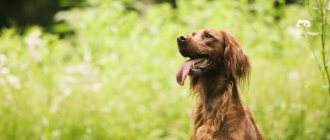If you like dogs of this breed and you decide to purchase such a wonderful pet, then please carefully study all the nuances of their maintenance and upbringing.
After reading this article, you will learn about the characteristics of Rottweiler puppies, the rules for caring for them and what you should pay attention to when choosing and purchasing. And also how to properly raise a puppy of this beautiful breed.
Website about dogs
The Rottweiler is one of the most popular dog breeds in the world.
A reliable, incorruptible guard who is at the same time capable of the most tender affection for members of his human family, this dog requires a balanced approach when deciding to take a pet home. The Rottweiler is a serious dog that needs the same serious attitude from its owners.
In general, the Rottweiler is a fairly healthy dog, but there are still a few things that can develop into problems. Often these large, heavy dogs suffer from diseases and pathologies of the musculoskeletal system. To protect your pet from a similar fate, you should pay attention to its diet from puppyhood. It is better to feed a Rottweiler puppy with ready-made high-quality food such as Royal Canin dog food, choosing exactly the food that is designed for such dogs, taking into account the age of the puppy. This will allow him to create a complete diet containing all the necessary vitamins, minerals and nutrients responsible for the normal growth and development of the puppy.
It is important to never overfeed your dog - at any age. Pleading “hungry” eyes should not mislead you. If it is difficult for you to independently determine the dog’s condition, contact an experienced veterinarian who will tell you in which direction you need to adjust the diet so that it is optimal. Excess weight is unacceptable for a Rottweiler. This is an extra load on the heart and joints, and these are already not the strengths of these dogs.
Don’t feed your dog just anything - it’s better to stick to some good food and strictly follow the manufacturer’s dosage instructions. Royal Canin food is an excellent option for not having to think about whether you have chosen the right menu for your pet.
Like any other representative of the Molosser group, the Rottweiler is quite susceptible to infectious diseases.
It is mandatory that a Rottweiler puppy be vaccinated as a preventative measure - annually, with complex vaccines against distemper, enteritis, viral hepatitis, adenovirosis, leptospirosis and rabies. It is better to check the vaccination plan at your veterinary clinic. Do not forget to treat for parasites - worms - the day before, 10-14 days before any vaccinations.
The Rottweiler is a late maturing dog. Do not demand from him at 6 months the same agility as from a terrier - the Rottweiler is still “damp”, his backbone is forming, and he will still catch up with his own. But excessive load with jumping is now undesirable for him.
Be sure to treat your puppy and then your adult dog for ticks. Piroplasmosis is now widespread, and even city dogs that do not visit forests and fields suffer. This is the very case when it is better to be careful.
Required vaccinations
The innate immunity received by the puppy from its mother protects it from viruses and infections for 2-2.5 months. After this, the puppy requires vaccinations to help develop its own immunity.
Vaccination protects your dog from:
- plague;
- hepatitis A;
- rabies;
- leptospirosis;
- viral enteritis;
- adenovirus;
- parainfluenza.
NOTE!
You cannot vaccinate a puppy during illness, after a recent illness or during the period of teeth change, and before vaccination it is necessary to carry out deworming.
Vaccination and deworming schedule:
- 14-21 days – deworming;
- 4-5 weeks – 1 vaccination, DP -pappi;
- after 10 days – removal of worms;
- 7-8 weeks – 2 vaccinations, DHPPI+L;
- 10-11 weeks – 3 vaccinations, DHPPI+L;
- 14-15 weeks – deworming;
- 6 months – 4 vaccinations, DHPPI +L;
- 8 months – 5th vaccination, Nobivak Rabies rabies vaccine;
- 1 year – 6th vaccination, DHPPI+L.
DHPPI+L and rabies vaccinations must be repeated annually.
Upbringing
Rottweilers are smart and cunning in their own way. These dogs know how to observe and draw conclusions. You must be consistent and stubborn in achieving your goals while raising this dog, otherwise the little mouth, sensing weakness, will sit on your head and begin to command from there.
Start parenting as early as possible. Definitely - with obedience. The Rottweiler already has enough innate aggression; if desired, you can “format” it, directing it in the right direction. But in the initial stages, complete obedience must be achieved, otherwise problems cannot be avoided. This is not a pocket dog - it is a serious animal of decent weight, with a quick reaction and not very developed cordiality towards strangers.
When accustoming your puppy to its name, begin to teach it and come to you on command, rewarding it with treats and games. Then connect “sit”, “place”, “near”, “not allowed”. If desired and possible, it makes sense to go to a training ground (only with all vaccinations done!). This is useful for you as an owner, and good socialization for your pet.
Types of muzzles
This table lists the pros and cons of different types of muzzles:
| Type of muzzle | pros | Minuses |
| Plastic |
|
|
| Metal |
|
|
| Closed leather |
|
|
| Open leather |
|
|
| Nylon |
|
|
Feeding and caring for a Rottweiler puppy at home
A dog in the house is a source of not only joy, but also of great responsibility. Before getting a pet, you must first clearly understand the purpose of its presence in the house (for security, company, or other things), and also analyze the possibility of fulfilling your responsibilities to it (proper feeding, walking, training, and so on).
If you need reliable security, and at the same time pleasant dog company, then you can safely choose such a popular breed as the Rottweiler.
The Rottweiler amazes with its versatility. After all, with proper upbringing, he is able to simultaneously be a serious protector of the owner and an affectionate friend of the child.
There is still debate about the origin of these dogs, but there is a version that the ancestors of Rottweilers regularly served Roman society, in particular the legionnaires. Additionally, some experts tend to think that this breed is descended from the Tibetan Mastiff. One way or another, the small town of Rottwil in southern Germany is recognized as the homeland of Rottweilers .
Excursion into history
According to some sources, modern Rottweilers are descendants of legionnaire dogs from Ancient Rome. They guarded the warriors' cattle, which they drove with them when they went on campaign. In appearance, the dogs resembled not only Rottweilers, but also Neapolitan mastiffs.
The Rottweiler dog breed received its name from the city of Rottweil, which is located in Germany. In it, farmers held fairs, and dogs helped them manage their livestock.
Pets had many important tasks. They herded the cows into a herd and made sure no one was left behind. Sometimes the dogs had to subdue aggressive bulls.
When trains began to operate, cattle began to be transported by rail, and the profession of a driver ceased to be relevant. The police paid attention to Rottweilers, and the popularity of the breed increased.
Brief description of the breed
The Rottweiler is a large breed. The weight of an adult dog is more than 42 kg, and its height ranges from 56-68 cm depending on the sex of the animal.
By all standards, the color of the dog should be black with red tan. Other options do not meet the breed requirements.
By nature, the Rottweiler is cunning, soft and affectionate; it is sometimes even compared to a cat, but only for members of its family. If he feels seriously threatened, he will turn into a ruthless protector of the pack (family).
Considering that the dog’s instinct to protect its owner comes first, it must be trained to avoid the manifestation of causeless aggression. The Rottweiler is easy to train, you just need to overcome its natural laziness. In addition to training, do not forget about the early socialization of the dog.
If a person does not have experience raising this type of dog, then they should entrust the dog to a professional or think about choosing a different breed.
Protective guard service
Raising an independent and obedient dog is not an easy task, especially if it is a Rottweiler. Raising a puppy for protective guard duty is an even more difficult task. That is why it is carried out by professional dog handlers.
A cross between a shepherd and a Rottweiler (Malchover): description of the breed
All training is aimed at developing the necessary skills, including security, protection, the ability to look for a trace, etc.
Note! Few people need such courses in everyday life, so these skills are not taught to domestic dogs. If the owner tries to do this on his own, most likely, he will not succeed, but the dog’s psyche will be undermined.
How to feed a Rottweiler correctly
A dog’s diet is the second important point after upbringing and training. How long Rottweilers live at home depends on the quality of the diet and the correct feeding regimen. And they live a long time: with good care, up to 12 years.
Basic feeding rules
Veterinarians and breeders advise following the following recommendations:
- A bowl of clean water should always be within the dog's reach.
- If food remains after eating, it must be removed. The next portion should be given at the next feeding time.
- You should not change the brand of food unless necessary. In case of allergies or food intolerance, new food should be introduced gradually, replacing some of the familiar food with new food.
Types of feed
The Rottweiler's diet should be varied. You can feed dry food or natural food:
- Dry food. The main advantages of industrial food are a balanced combination of ingredients and saving the owner’s time on preparing food for the dog. Food should be purchased at least premium. They are of higher quality compared to inexpensive analogues and can provide the Rottweiler with all the necessary nutrients for a full and healthy life.
- Natural food. The main part of the food is meat and offal. In addition to them, sources of protein for your pet can be fermented milk products, eggs, and low-fat fish. The Rottweiler gets carbohydrates from rice and buckwheat, and fiber from vegetables. Prohibited foods are sweets, milk, and tubular bones.
How to care for a Rottweiler puppy
Rottweilers are fairly large dog breeds. In order for a dog to grow up healthy and live for a long time, it is necessary to pay attention to its nutrition and physical activity from the very “childhood” age.
In addition to caring for the dog, the owner should try to adapt it as much as possible to life in the family, since the tendency to dominate is one of the main character traits of this breed. You will have to socialize your four-legged friend from the moment he is separated from his mother.
How to care for a Rottweiler and how to raise a four-legged friend are the main questions that concern novice dog breeders.
First lessons
Now let's move on to practice and talk about how to properly raise a Rottweiler. From the first day in your home, the puppy should become familiar with its name. This is the key to further achievements. Now we are gradually starting to practice basic obedience skills. Any time you are watching TV, cooking dinner, or watching your puppy frolic, call his name and give the command “Come.” You can lightly slap the leg so that the baby understands what is required of him. Now praise and release with the command “Walk”.
It is equally important to determine your dog's position. It should be comfortable and cozy. On the very first night, put a piece of diaper from the mother's nest into it and give the command “Place”. At first you will have to get up often to calm the baby, stroke it and give warm milk, but then repeat the command and go to bed. So, gradually, the baby develops an image of this world in which you are an adored master, whose word is the law.
Rottweiler - care and maintenance
One of the basic rules for caring for a Rottweiler is to constantly expose it to physical activity. This will help keep your dog in good shape. In addition, representatives of this breed themselves prefer an active lifestyle.
If your dog lives in an apartment, how can you ensure it is well cared for and active? There are several methods.
- Walk your Rottweiler in an area where he can run and play freely. This could be a designated area for walking dogs, a large park, or a vacant lot. For those who live outside the city, finding a piece of pristine nature is much easier.
- Take an active part in your pet's games. Of course, it is best to do this outside. Bring a ball or other toys designed for dogs. You can use “improvised” means. Any thick and short stick will do, so that your pet will enthusiastically chase it and bring it back, proudly laying it at your feet.
- Lucky are those dogs whose owner loves hunting. The Rottweiler will be an excellent assistant, as he will enjoy this activity. If the hunting season is not open, you can go photo hunting. The main thing is that there is a lot of movement and the dog can realize its needs for running.
Those who have got a dog for the first time are especially concerned about the question of how to care for its fur . Rottweilers do not need constant brushing. Only during molting they will have to be carefully combed. Especially if the pet lives in an apartment and not in an enclosure.
Appearance
The muscular, but compact, proportionally built figure of the Rottweiler indicates the enormous strength and endurance of the animal. Males are more massive than females in all respects. Male height is 60-68 cm at the withers. The height of the Rottweiler female is shorter - 56-63 cm. The body length does not exceed the height at the withers by more than 15%. Rottweiler weight – 40 – 60 kg.
Head
Wide in the skull. The developed occipital protuberance does not stand out much.
The nose is large. Round. Definitely black.
The muzzle is proportional. Not shortened and not stretched. The lips are black, tightly closed. The zygomatic arches are clearly defined. The jaws are powerful and wide. They provide the crushing grip of Rottweilers.
Rottweiler teeth
Strong and tough. The upper incisors meet in a scissor-like manner with the incisors of the lower jaw. In this case, the mandibular canines enter the spaces between the extreme incisors and the canines of the upper jaw. Form a strong castle. Provides the animal with a strong grip.
Eyes
Dark brown, expressive. Medium size. Almond-shaped. The eyelids fit tightly. The look expresses confidence and good nature.
Ears
Triangular shape. Hanging. With the correct position, shape and size, they expand the line of the dog’s head. They fit her full face into an isosceles triangle. The ears make up 37% of the total width of the head and give the dog a noble appearance.
Neck
Moderately long, thick, with a strongly developed scruff.
Frame
The chest is deep. Wide. The back is muscular.
Forelegs
They serve as a support and hold the animal’s body when moving. Straight, widely set. Thanks to this, the dog is difficult to knock down even with a very strong blow. This is important when fighting with opponents and intruders.
Hind limbs
The pelvic limbs have a more powerful skeleton than the forelimbs. Hips with a powerful layer of muscles. The hock joints are dry and clearly defined. Their angle is 125 - 135 degrees. There should be no dewclaws on the paws.
Tail
Highly placed. Thick at the base. Initially, the breed standard provided for mandatory tail amputation. 1-2 vertebrae were left. Currently, tails are not docked in European countries and the United States. It is not the length of the tail that is important, but its position. The dog should hold it horizontally and not tilt it behind its back.
Coat
The coat is short, close-lying, and harsh. Dogs kept on the streets are coarser, thicker and longer than those living in apartments.
Rottweiler color
Black and tan. Tan marks refer to rich red-brown or yellow spots of varying intensity. They are located in strictly defined places of the head, torso, and limbs.
The black and tan Rottweiler always looks elegant.
Very rarely, litters may produce a golden and white Rottweiler. They are not allowed to participate in exhibitions or breed. Despite this, there is a belief that “golden Rottweilers” bring happiness to their owners.
Movements
Free and smooth. The characteristic gait is a heavy gallop.
Common disqualifying faults
- Sex type displacement. Bitch type in males. Male in bitches.
- Cowardly or angry behavior. Hypertrophied distrust Nervousness.
- Malocclusion. Missing one or more teeth.
- Longhair. Wavy coat.
How to care for a Rottweiler puppy - health and nutrition features
Many large dogs, including Rottweilers, are at risk of developing osteochondrosis and arthrosis. In addition, with age, problems with the hip and elbow joint may appear. An adult dog can weigh about 50 kilograms. In just 12 months of its life, the puppy increases its body weight, increasing it 80 times.
In order for your baby’s musculoskeletal system to develop correctly, it is necessary to supply his body with useful elements׃
- glucosamine;
- fatty acids EPA and DHA;
- chondroitin.
This breed is predisposed to diseases such as
- diabetes;
- cataract;
- obesity;
- cardiological pathologies.
Proper nutrition can help relieve some health problems. Specialized food for puppies of this breed “Rottweiler Junior” will help the pet develop properly and receive all the necessary vitamins, fats, acids and minerals. When a dog turns 1.5 years old, it can be switched to dry food intended for an adult dog. For example, on Rottweiler Adult.
Why is this food useful?
- helps to avoid problems with joint diseases;
- keeps your pet in shape - prevents obesity;
- Constantly gnawing on croquettes increases the strength of teeth and gum health, and prevents the formation of tartar.
Rottweilers need large meals. In the first two months, the puppy should receive food several times a day. Then food intake is reduced to 3-4 times. An adult dog is transferred to two feedings a day.
If your pet eats dry food, you must adhere to the dosages indicated by the manufacturer on the packaging. While Rottweilers cannot be overfed, feeding them once a day is not acceptable.
Is it possible to keep a Rottweiler outside in winter?
This issue still remains unresolved. Some owners keep their dogs in a kennel all year round. Others argue that the Rottweiler has too little fur for him to survive the winter outside without problems.
If it is not possible to house your pet for the winter, make sure that its “wintering” is comfortable and safe. The kennel should be insulated as much as possible, and during severe frosts, figure out how to provide the “dog house” with additional heating. Otherwise, it is better to take your four-legged friend home for the night.
What age is best to start?
Puppy training begins at one month of age. Animals are first trained to:
- respond to nickname;
- use a special toilet;
- walk on a leash.
The puppy learns basic skills from its mother. When he is brought to another house, a person begins to be responsible for the fate of the baby. The Rottweiler performs its first commands from the age of two months. You cannot miss moments when your pet stops following orders.
From the very beginning, you need to prevent any antics of the puppy, from which bad habits can form:
- grab hands;
- show aggression towards family members;
- offend other animals.
Is it possible to keep a Rottweiler on a chain?
If you want to have a dog in your yard that will sit on a chain, it is better to get a “Caucasian” or a Moscow watchdog. The “specialization” of Rottweilers is like this
- watchman;
- bodyguard;
- guard;
- family companion;
- security guard.
This dog is not suitable as a chain watchdog. Caring for a Rottweiler involves giving your pet the opportunity to realize his potential and physical capabilities. This is a very good-natured family breed, but in case of danger that threatens the owner or his home, he becomes a formidable defender.
Bitch: character
There is an opinion that Rottweiler bitches have a more submissive and gentle character. But experts believe that character largely depends on heredity and individual characteristics. There are always exceptions, bitches with a very difficult character, and there are males with an easy-going and submissive character. But still, there is a difference in the behavior of the sexes. There are advantages and disadvantages for female and male genders.
Advantages:
- Strong relationship with owner and home
- Emotionally sensitive perception
- Girls are smarter and smarter than boys
- Accepts training tasks well
- During walks, he runs less in the bushes
- Doesn't rush at strangers
- The breed is ideal for breeding, just one assessment from the exhibition is enough
Flaws:
- Sly
- Periodic menstruation
